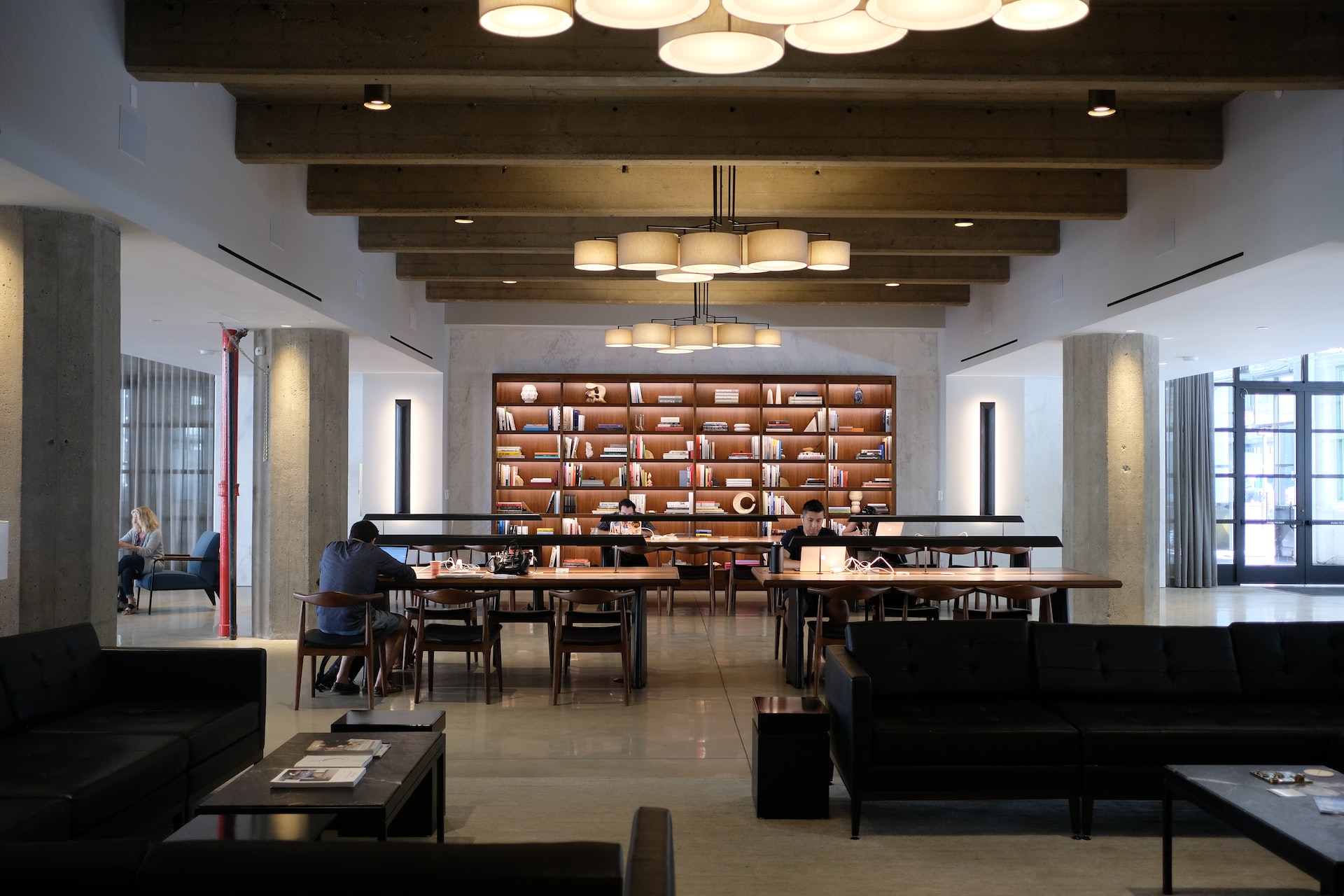What is a flexible workspace?
“Flexible workspace” is a term that refers to offices – or desk spaces – that come with short-term rolling contracts as opposed to long leasehold commitments. A traditional office lease can last for a number of years, whereas offices or desks in flexible workplaces can be rented on a monthly, weekly, or even daily basis.
You could say that flexible workspaces are more like a subscription service. Instead of being called tenants, people who rent a desk or office in a flexible workspace are typically called ‘members’. Because there’s way less commitment involved, flexible workspaces provide business owners with more control over their cash flow.
Another thing flexible workspaces have in common is the way that services are charged. The majority of operators charge an all-inclusive monthly fee; this covers rent, utilities, bills, cleaning, and the costs associated with running the building. Some things – including meeting room usage – are added to the monthly bill.
What is a flexible workspace operator?
Flexible workspaces are usually run by an ‘operator’. The operator may own the building or they might lease it from a commercial property landlord. Operators usually place a team in each of their buildings. This team is responsible for managing day-to-day operations and what’s known as the “member experience”.
Flexible workspaces vary in size: they range from small, single-floor spaces to huge multi-storey complexes. The operators range in size too – WeWork is probably the most famous example of a global coworking brand, but there are thousands of smaller independent coworking spaces out there, all around the world.
Flexible workspace features
No flexible workspace is exactly the same. As you’ll find out further on, some are designed with the needs of specific sectors in mind, while others have a wider appeal. Most are pre-furnished, providing members with ergonomic desks and chairs. Security and high-speed internet are also flexible workspace staples.
Many flexible workspaces include some or all of the following:
Meeting rooms
Breakout areas
Kitchens or cafes
In-house team
Event spaces
Exercise spaces, e.g. yoga room or gym
Meditation/prayer rooms
Showers
Bike storage
These perks can help members attract and retain employees. Operational flexibility has always been attractive to businesses, not least to all those that haven’t been trading for long. Since the pandemic, the majority of businesses see the value in flexibility, including established ones. Flexible workspaces are growing in popularity and a growing number of traditional landlords are pivoting into the flexible market.
Types of flexible workspaces
Flexible workspace is an umbrella term that covers a few different options, namely coworking spaces, shared offices and niche workspaces. Because the flexible commercial property market is still relatively new (it’ll be 30 years old in 2025), new terminology is entering the lexicon every single year.

Coworking spaces
Coworking spaces are designed with the concept of community in mind. The organisations that call them home are diverse: depending on the coworking space, you’ll find freelancers, individuals whose employers have agreed to let them work in a coworking space, startups, SMEs and even teams from large corporate brands.
Coworking is:
Community-driven
Social
Professional
Collaborative
Creative
The Melting Pot in Edinburgh is an example of a coworking space. In fact, it was one of the UK’s first. Founded by Claire Carpenter in 2007 it’s a hub for people working in the charity sector; somewhere to work, pool resources, make connections and get support. Impact Hub is another example. This global organisation is “founded by local innovators who care deeply about making a difference in their community.”
Shared offices
The term ‘shared offices’ is used in two different contexts. The first is to refer to offices that are sublet by the business or individuals occupying them. For instance, a 5-person room in a creative studio might be rented by one person who, as well as working there themself, sublets the additional desks to other creatives too.
The second is used to describe a shared building. While the offices in the building are usually private (occupied by people from the same organisation), the amenities are shared. Sounds similar to a coworking space, right? The terms coworking space and shared office are often used interchangeably. Shared offices are sometimes referred to as serviced offices too. There are a lot of crossovers!
Niche flexible workspaces
Then there are niche spaces. As coworking grows in popularity more niche flexible workspaces are popping up. Niche coworking spaces cater to people who have something in common. This could be to do with identity, such as gender (see coworking spaces aimed at women), or the industry the people work in.
We’ve written a lot about niche coworking spaces over the years. Check out our blog articles for in-depth insights and examples of the following:
Coworking spaces for scientists
Coworking spaces for film professionals
Coworking spaces for those working in mental health
Coworking spaces for games developers
7 flexible workspace ingredients
Although running a flexible workspace can be hugely rewarding, it’s also challenging and can be difficult to become profitable in the early days. If you’re interested in setting up a coworking space, consider speaking to those who have been through the experience already. There’s a lot to draw on, such as coworking founders’ experiences of funding and how to build community before launching.
Here are seven key things to think about at the beginning of your journey:
Idea – What makes your coworking venture unique and viable?
Property – Do you have a location in mind and can you afford it?
Funding – How will you fund your coworking project?
Audience – Who is your target market and how will you reach them?
Brand – What will be your brand’s core principles and personality?
Community – How will you establish and grow your coworking community?
Flexible workspace software – What software will you use to run your space?
Nexudus is a flexible workspace software solution that enables coworking and shared office operators to run their space. You can use it to manage bookings, access control, enquiries, events planning – and more. Book a demo today to find out how Nexudus can help you take your flexible workspace idea to the next level.
Related stories
Global Coworking Trends and Opportunities for 2025
Now well into 2025, the coworking industry continues to demonstrate strong momentum. With demand for coworking spaces remaining steady around the globe, it's clear that coworking is not just enduring—it's thriving. Let’s explore the major trends and opportunities shaping the global coworking landscape this year.
Creating Events that Drive Community Engagement in Coworking Spaces
Community is everything in coworking, but a genuine sense of connection between members doesn’t magically happen overnight or by chance. Often, meaningful relationships take intentionality, effort, and time to build, with events being an effective vehicle for bringing people together around shared interests, goals, and experiences, creating opportunities for collaboration, and a thriving coworking culture. This article looks at creating events that drive community engagement in coworking spaces.
Liz Elam: ‘Community is the number one amenity in coworking spaces’
A household name in the global coworking industry, Liz Elam, is the founder of one of the world’s best coworking event series: GCUC. Liz’s coworking roots began in 2010, when she established Link Coworking – a welcoming, affordable, and professional coworking space – in her hometown of Austin, Texas. Link Coworking achieved incredible success, expanding across three locations and becoming the fourth-largest coworking brand in Austin. It was sold in 2019, making Liz the first woman globally to exit a coworking brand.
Key Takeaways from the Coworking Alliance Summit 2025
Gathering online for the Coworking Alliance Summit last week, members of global coworking alliances, coworking spaces, and community leaders came together to navigate global issues, strengthen ties across the coworking industry, and work collectively towards future goals.
5 Ways to Reduce Noise in Open Offices & Coworking Spaces
Some people like working against a background of noise, while for others it’s their worst work nightmare. The truth is, our relationship with noise depends on our own preferences and the nature of our work.
Key takeaways from the Workspace Design Show 2025
London’s Workspace Design Show is undoubtedly one of the best coworking events of 2025. For one, the exhibition (held at Islington’s Business Design Centre) features a host of innovative and creative workspace design solutions tailored to the needs of modern workplaces.
What Is Workplace Management and Why Does It Matter?
There has always been a need for workplace management – the process of organising and optimising physical spaces, resources, and operations to support people’s needs. But, as 28% of UK working adults were reported to work in a hybrid capacity last autumn (by the Office for National Statistics), the question of ‘why workplace management matters’ is more critical than ever. Let’s look at the workplace management benefits for your operations.
10 Smart Goals for your Coworking Space: How to Set & Achieve Business Objectives
Coworking is synonymous with creativity, collaboration and productivity. Businesses and freelancers love coworking spaces because (by surrounding themselves with fellow workers) they’re more likely to achieve their goals. The coworking environment, while social, is set up to facilitate focused, distraction-free working.
The Best Coworking Events in 2025: Must-Attend Gatherings for Professionals
Managing coworking spaces is an all-encompassing role, often leaving operators, owners, and community managers with little time to focus on personal growth or draw inspiration from others.
10 Award-winning Coworking Space Designs: A Comprehensive Guide
Vibrant, contemporary workspaces create an undeniable ‘wow’ factor. Textured designs and ambient lighting make spaces feel warm and cosy, while natural elements and biophilic design features have literal mood-boosting properties.

